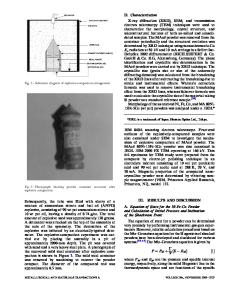Mechanical alloying of Fe and V powders: Intermixing and amorphous phase formation
- PDF / 713,173 Bytes
- 6 Pages / 593.28 x 841.68 pts Page_size
- 104 Downloads / 348 Views
G. Le Caer Laboratoire de Science et Genie des Materiaux Metalliques, associe au CNRS U.A. 159, Ecole des Mines, 54042 Nancy Cedex, France
P. Matteazzi Universita di Udine, Istituto di Chimica, v. Ungheria 43, 33100 Udine, Italy (Received 10 April 1989; accepted 27 June 1989)
Mossbauer spectrometry and x-ray diffractometry were used to characterize the microstructural changes that occurred during the mechanical alloying of Fe and V powders. After 3 h of essentially no interatomic intermixing, an Fe-V alloy began to form. At first the chemical composition of this alloy was highly inhomogeneous, having large variations over distance scales of less than 100 A. After about 24 h of ball milling, the alloy homogenized and then became at least partly amorphous.
I. INTRODUCTION Although the technique of mechanical alloying is not new,1 research in mechanical alloying has been stimulated in the last two years by reports of amorphous phase formation.2"5 There remain, however, many unanswered questions about how mechanical alloying occurs. Particularly poorly understood is the transition from the communition of the original powder particles to interatomic intermixing. These stages of mechanical alloying are difficult to study by most experimental techniques because of the highly defective nature of mechanically alloyed microstructures. To study the intermixing process at the atomic level, we undertook a study of mechanical alloying by Mossbauer spectrometry. In an earlier study, Mossbauer spectrometry was used to explore the composition range of amorphous phase formation of Fe-Zr alloys.6 In the present study, we used Mossbauer spectrometry to analyze the evolution of the local compositions during the mechanical alloying of Fe and V powders. This choice of elements was motivated in part because of the straightforward systematics of how 57Fe hyperfine magnetic fields (hmf's) are perturbed by surrounding V atoms,7"11 and because the magnetic properties of Fe-V alloys are also well established.12'13 The Fe-V alloy system forms a broad range of bcc solid solutions, suggesting that there could be a broad range of local chemical environments in the mechanically alloyed powders. From the local chemical information deduced from 57Fe Mossbauer spectra, we expected to measure the changes during mechanical alloying of the atomic fractions of Fe atoms situated in nearly pure Fe, in nearly pure V, and in the intermixed Fe-V alloy. In addition, the existence of an equilibrium sigma phase near the equiatomic composition, whose formation could perhaps be kinetically suppressed, suggested to us that a crystalline1450
http://journals.cambridge.org
J. Mater. Res., Vol. 4, No. 6, Nov/Dec 1989
Downloaded: 24 Jun 2014
to-amorphous transformation might occur during mechanical alloying.
II. EXPERIMENTAL Elemental powders of Fe having a purity of 99.0% and a particle size of 60 microns and V having a purity of 99.7% and a particle size of 44 microns were mixed in equiatomic proportions. The powders were sealed in tungsten carbide vials with t
Data Loading...











